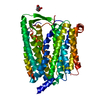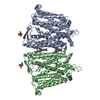+Search query
-Structure paper
| Title | Structural basis for recruitment of TASL by SLC15A4 in human endolysosomal TLR signaling. |
|---|---|
| Journal, issue, pages | Nat Commun, Vol. 14, Issue 1, Page 6627, Year 2023 |
| Publish date | Oct 20, 2023 |
 Authors Authors | Xudong Chen / Min Xie / Sensen Zhang / Marta Monguió-Tortajada / Jian Yin / Chang Liu / Youqi Zhang / Maeva Delacrétaz / Mingyue Song / Yixue Wang / Lin Dong / Qiang Ding / Boda Zhou / Xiaolin Tian / Haiteng Deng / Lina Xu / Xiaohui Liu / Zi Yang / Qing Chang / Jie Na / Wenwen Zeng / Giulio Superti-Furga / Manuele Rebsamen / Maojun Yang /    |
| PubMed Abstract | Toll-like receptors (TLRs) are a class of proteins that play critical roles in recognizing pathogens and initiating innate immune responses. TASL, a recently identified innate immune adaptor protein ...Toll-like receptors (TLRs) are a class of proteins that play critical roles in recognizing pathogens and initiating innate immune responses. TASL, a recently identified innate immune adaptor protein for endolysosomal TLR7/8/9 signaling, is recruited by the lysosomal proton-coupled amino-acid transporter SLC15A4, and then activates IRF5, which in turn triggers the transcription of type I interferons and cytokines. Here, we report three cryo-electron microscopy (cryo-EM) structures of human SLC15A4 in the apo monomeric and dimeric state and as a TASL-bound complex. The apo forms are in an outward-facing conformation, with the dimeric form showing an extensive interface involving four cholesterol molecules. The structure of the TASL-bound complex reveals an unprecedented interaction mode with solute carriers. During the recruitment of TASL, SLC15A4 undergoes a conformational change from an outward-facing, lysosomal lumen-exposed state to an inward-facing state to form a binding pocket, allowing the N-terminal helix of TASL to be inserted into. Our findings provide insights into the molecular basis of regulatory switch involving a human solute carrier and offers an important framework for structure-guided drug discovery targeting SLC15A4-TASL-related human autoimmune diseases. |
 External links External links |  Nat Commun / Nat Commun /  PubMed:37863913 / PubMed:37863913 /  PubMed Central PubMed Central |
| Methods | EM (single particle) |
| Resolution | 2.95 - 3.25 Å |
| Structure data | EMDB-36751, PDB-8jzr: EMDB-36752, PDB-8jzs: EMDB-36753, PDB-8jzu: |
| Chemicals |  ChemComp-NAG:  ChemComp-CLR: |
| Source |
|
 Keywords Keywords | PROTEIN TRANSPORT / endolysosomal transporter |
 Movie
Movie Controller
Controller Structure viewers
Structure viewers About Yorodumi Papers
About Yorodumi Papers









 homo sapiens (human)
homo sapiens (human)